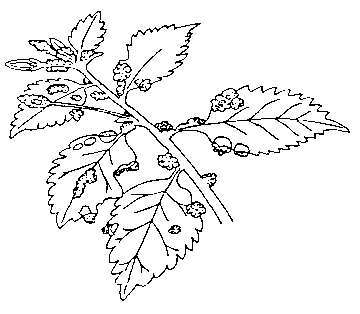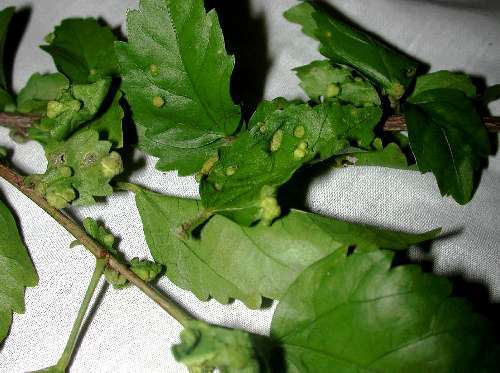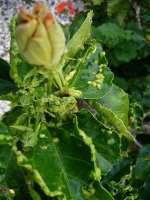|
Hibiscus erinose mite
Symptoms Damage is most clearly seen on the young leaves and the developing vegetative buds of hibiscus shrubs. Symptoms include extreme pimpling of the leaves, leaf axillary buds, petioles and calyces. A common character is the production of pockets of galled tissue, which are most obvious on the lower surface of the leaf as yellow, velvety - overgrowth. The leaf axils are particularly distorted, as are the proximal margins of the leaves.
The mite The distortion is caused by a microscopic erinose (eriophyid) mite Eriophyes hibisci, also known as the hibiscus erinose mite, the hibiscus erineum mite or the hibiscus leaf crumpling mite. World wide, E. hibisci is found in Brazil, Hawaii and South Sea Islands such as Tonga and Fiji. It was probably introduced to Australia on illegally imported hibiscus cuttings. Erinose mites are worm-like in appearance and have only two pairs of legs. They inject salivary compounds into expanding green tissue. This stimulates a plant reaction far out of proportion to the size of the mite, whose presence is indicated by the velvet-textured galls. The mites themselves are so small (160-185μm) that they are difficult to detect even on the highest magnification of a stereo microscope. Erinose galls often have a range of more readily visible mites such as predatory mites (phytoseiids) that feed on the eriophyids. Unfortunately, in this case the predators are apparently not efficient enough to prevent galling.
Colony characteristics Control Affected plants should be pruned to improve their appearance prior to spraying. Existing galls will persist on the plant until the affected tissue dies, making it difficult to judge the success of sprays. The aim of the spray programme is to protect new growth. . The Department of Primary Industries has obtained a special (board) approval for the use of chlorpyrifos to control this pest in cropping situations. Applied as a spray at four weekly intervals throughout the year, chlorpyrifos appears to protect hibiscus in high risk localities. In particular, frequent sprays are needed during the main growth period to renew protection. There is no chemical currently registered for use in the home garden against this pest. To avoid spreading this problem, enthusiasts are reminded not to move cuttings from infested areas into other districts. Badly effected shrubs and prunings should be removed and either burnt, buried or taken to the dump in an enclosed plastic bag.
Further information Direct home garden enquiries to: Direct commercial enquires to: DPI Call Centre Centre for Amenity and Environmental Phone: 13 25 23 (8 a.m. to 6 p.m.) Horticulture, (Queensland residents). Non Queensland Department of Primary Industries, residents phone 07 3404 6999. Delancey Street, E-mail callweb@dpi.qld.qov.au Cleveland. Q 4163. Phone: 07 3286 1488 Information contained in this publication is provided as general advice only. For application to specific circumstances, professional advice should be sought. The Department of Primary Industries, Queensland, has taken all reasonable steps to ensure the information in this publication is accurate at the time of publication. Readers should ensure that they make appropriate inquiries to determine whether new information is available on the particular subject matter. © The State of Queensland Department of Primary Industries, 2000 - ISSN 0155 – 3054 Produced by: Queensland Horticulture Institute - Revised December 2000 File No: H0054_____________________________________ No of pages (2)___________________ Replaces (H00054) |



